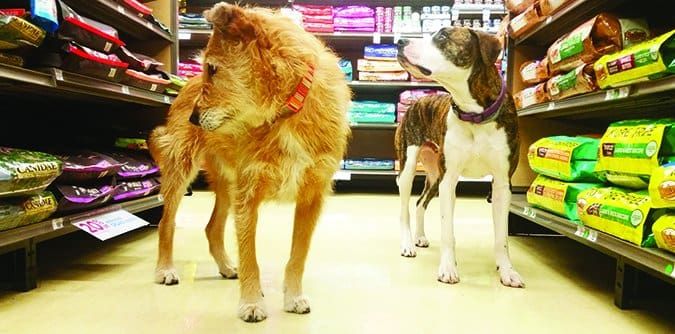[Updated January 28, 2019]
How do you select your dog’s food? Do you just buy what your dog’s breeder recommended? Get whatever dog food is on sale? Ask the sales clerk for his opinion? Well, that’s too bad; none of these methods allow for a thorough dog food analysis, or take into account all the factors that should be considered in order to buy and feed the food that best suits your dog and you. There’s a better way! Before you jump into our Whole Dog Journal-Approved Dog Food Lists, here are 10 important points to investigate and contemplate as you shop.
1. Buy the best dog food you can afford.
Good dog food costs a lot more than low-quality dog food because good dog food is made with better-quality ingredients, which cost more than low-quality ingredients.
That said, the most expensive food is not necessarily the best, nor does the price always correlate precisely with a food’s quality. There are lots of low-quality foods that are sold for good-food prices, because some companies spend a ton on marketing and advertising!
There are bad, better, good, and best foods at every price level. You should have an idea of how much you are willing to spend; look for the best foods you can find at the level you can afford.
How can you determine which foods are the good and bad ones at your price point? Read on!

If you have more than one dog, don’t forget that you can, and maybe should, feed each of your dogs a different food. Your adolescent Lab-mix might be able to eat practically anything and look like a million bucks, but your arthritic, allergic Border Collie might need a grain-free food with a novel protein in order to keep physically sound and not constantly itching.
To get an idea of what different dog owners feed their dog according to their individual needs, see “Every Dog is Different: Examples of Dog Food Buying Decisions.”
2. Don’t always choose the same dog food, or even dog foods from the same company.
Many companies use the same vitamin/mineral pre-mix in every one of their products. This means that the nutrient levels in all the foods in the company’s product line will likely have very similar nutrient levels. If you feed the same food (or even different foods from the same company) for months or years on end, your dog could develop problems caused by nutritional deficiencies or excesses.
It seems odd, but there is a wide range of nutrient levels allowed in foods that are legally described as “complete and balanced.” (For more information about why this is so, see “2016 Approved Dry Dog Foods: Whole Dog Journal’s Annual Ratings,” in the February 2016 issue.) Some products have levels of some minerals or fat-soluble vitamins that are inadequate or excessive. These imbalances won’t cause problems in a short period of time, but if you never vary your dog’s diet, the deficiencies or excesses compound over time and can cause health problems. Periodically switching your dog’s diet to products from different companies prevents this.
3. Look for the AAFCO statement on your dog food’s label and make sure the food is “complete and balanced” for dogs in your dog’s life stage.
Some foods are formulated to meet the nutritional requirements of adult dogs only. If you are feeding a puppy, a high-performance athlete, a pregnant or nursing female, a dog who needs to gain weight, or a debilitated dog, you should look for a product that is formulated for dogs “of all life stages.” Products labelled with that statement must meet the higher nutrient requirements of puppies and pregnant or nursing mothers.
4. Check the protein and fat levels in the dog food’s Guaranteed Analysis.
The minimum levels of protein and fat that are guaranteed to be present in the food are listed in the “guaranteed analysis” (GA) section on the label. When you switch your dog’s food to a new one, you should be aware of how much protein and fat the old food contained, and how much is present in the new food. If the new food contains a lot more fat than the old food (as just one example), you will probably need to reduce the amount you feed your dog.
5. Look for the “best by” date on the dog food.
In general, you want to buy and feed the freshest food available. If a product is within six or fewer months of its “best by” date, we’d look through the pile for a fresher bag.
6. Save so-called “novel” proteins and exotic carbohydrate sources in store-bought dog foods for dogs who really need them.
There is zero benefit to feeding ostrich or alligator or even rabbit or quail to a dog who easily digests the most common animal proteins used in pet food (such as chicken, beef, lamb, and pork). However, if your dog ever develops an allergy to or intolerance of these common animal proteins, it will be invaluable to be able to employ more exotic animal proteins in an “elimination diet” (in which a protein that the dog has never eaten before is used).
The same principle applies to exotic carb sources. Carbohydrates such as quinoa, chickpeas, peas, and others are showing up in mainstream foods more and more frequently. Avoid them unless you need them for an elimination trial. (For more detail on this topic, see “Food Elimination Trial: A Valuable Tool” in the April 2011 issue.)
7. Look for dog food ingredients that your dog is allergic to or intolerant of.
This is (obviously) so you can avoid feeding a product that will distress your dog.
If you have proven, through your own feeding trials of various products, that your dog reacts badly to certain ingredients, you should be reading the ingredients list of every product you buy, to make sure the problematic ingredient isn’t present in the product. Don’t count on the fact that the ingredient wasn’t present in the last bag of the same product; food manufacturers do change their formulas from time to time.
8. Look for the following; these are good things you want to see on the ingredients list of your dog food:
– Lots of animal protein at the top of the ingredients list. Ingredients in pet food, just like human food, are listed in order of the weight of that ingredient in the formula, so you want to see a named animal protein or named animal protein meal first on the list. (“Named” means the species is identified: chicken, beef, lamb, etc. “Meal” means a dry, rendered product made from an identified species.)
– When a fresh, named meat is first on the ingredient list, there should be a named animal-protein meal immediately or closely following that fresh meat. Fresh meat contains a lot of moisture (which is heavy), so if meat is first on the list, it acts like a diluted protein source; while it adds an appealing flavor and aroma to the food, it doesn’t actually contribute that much protein. That’s why another named source of animal protein should appear in the top three or so ingredients.
– When vegetables, fruits, grains, and or carbohydrate sources such as potatoes, chickpeas, or sweet potatoes are used, they should be whole. Fresh, unprocessed food ingredients contain nutrients in all their complex glory, with their vitamins, enzymes, and antioxidants intact. Don’t be too alarmed by one or two “fractions” (a by-product or part of an ingredient, like tomato pomace or oatmeal), especially if they are lower on the ingredient list. But the more fractions present in the food, and the higher they appear on the list, the lower quality the result.
9. Don’t buy dog foods that contain the following ingredients; these are things to look out for:
– Meat by-products, poultry by-products, meat by-product meal, and poultry by-product meal. Many of the animal tissues that are defined as animal by-products are highly nutritious, but they are also considered waste products of the human food industry.
– “Generic” fat sources. “Animal fat” can literally be any mixed fat of animal origin; it need not have originated from slaughtered animals. Meaning, it can be obtained from renderers that process dead animals. “Poultry” fat is not quite as suspect as “animal fat,” but “chicken fat” or “duck fat” is better (and traceable).
– Added sweeteners. Dogs, like humans, enjoy the taste of sweet foods. Sweeteners effectively persuade many dogs to eat foods comprised mainly of grain fragments (and containing less healthy animal protein and fats).
– Artificial colors, flavors, or preservatives (such as BHA, BHT, ethoxyquin). The color of the food doesn’t matter to your dog. And it should be flavored well enough with healthy meats and fats to be enticing. Natural preservatives, such as mixed tocopherols, can be used instead.
10. Contact your favorite dog food makers and ask them for the complete nutrient analyses of their products.
It was a shock to learn, not long ago, that pet food companies don’t have to show regulators (or anyone else) any sort of proof that their foods contain all the nutrients that dogs need. Instead, they fill out and sign an affidavit stating that “This product meets the nutrient levels established in the AAFCO Dog Food Nutrient Profiles for (growth/reproduction, maintenance, or all life stages).”
In our opinion, since pet food companies make food that’s meant to provide 100 percent of the nutrients dogs need, they ought to be able to show some proof that their finished products do, in fact, contain the nutrients, in appropriate amounts, that they are supposed to, so we have begun asking companies to provide us with these analyses.
Some companies readily provided us with that information, and we have designated their products in bold under the Nutrient Analyses column in our list. Good job! Others provided us with computer-generated analyses of the nutrient levels that are expected in their finished foods. That’s something, but a little less than proof positive that those nutrient levels are, in fact, in line with the AAFCO Dog Food Nutrient Profiles. Those companies appear on our approved foods list, but without a bolded designation.
Companies who provided us with no documentation regarding the nutrient levels in their products have been omitted from our approved foods list.
For more information about why consumers should demand to see proof that their dogs’ food truly is “complete and balanced,” see “Ask For More,” in the October 2016 issue.
List of Approved Dog Foods
Here is a link to our lists of approved foods, where you can see our 2018 list! Please note that these are not the only foods on the market that meet our selection criteria. There may be other foods available to you that we are not familiar with. Read the label; if it meets the criteria we’ve outlined above, and it fits your budget and suits your dog, great! We suggest that you contact the company and ask for the complete nutrient analysis for your dog’s food, so you can compare it to the standards for “complete and balanced” canine diets. Then you can make an intelligent, informed decision to buy or not buy the food, based on their response.
Our approved foods for 2017:
2017 Whole Dog Journal Approved Dry Dog Food List







I’ve been meaning to buy dry food for my new dog Kate. Thank you for saying that it’s not advisable to always purchase the same dog food from the same company because they mostly contain the same level of nutrients. I hope I’ll be able to find a complete and balanced dog food for kate.